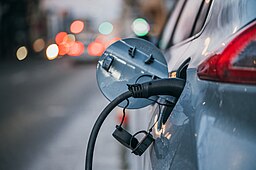source Ivan Radic, CC BY 2.0
There is good, early data showing that, so far, EVs are much less likely to catch on fire than Internal Combustion Engine (ICE) cars:
“Data from the U.S. National Transportation Safety Board shows that there are approximately 25 fires for every 100,000 EVs sold. In comparison, there are approximately 1,530 fires for every 100,000 gas-powered vehicles sold. Similar rates have been found in Norway, Sweden and Australia.” (from Electric Vehicle Fire Staged to Study Environmental, Health Ramifications | U Miami—more discussion here).
However, when exposed to high temperatures, EV’s lithium batteries catch on fire, burn very hot and for a very long time, and take many hours to extinguish: " the leading causes of EV battery fires are road traffic collision, submersion in salt water, battery fault during manufacture and exposure to another fire (EVs in Wildfires | EVFireSafe). In a California wildfire, both exposure to fire and salt water immersion (through a salt water plane dump) can occur.
The presence of an EV in a zone exposed to wildfire increases the dangers to structures nearby, because of the very long duration of a battery fire (7 hours is typical), the heat of the battery fire (5000°F, per Clemson U), and the difficulty to extinguish this fire. It takes about 2,000 gallons of water to extinguish a burning gasoline-powered vehicle; putting out an EV fire can take 10 times more (here is one story). Worse, though, is the danger that this same EV will be to the firefighters trying to fight a wildfire.
Leaving your EV near your house exposes your house to danger. Leaving your EV on the street exposes firefighters to danger, and risks making it impossible for a firefighting vehicle to drive by your house (if your EV catches on fire). And, If you wait too long, evacuating with your EV may also be more dangerous because you are now inside a vehicle that may burn hot and long if caught by fire, for instance while waiting for long traffic lines while attempting to evacuate.
So there are few safe options for a family that has at least one EV in their car portfolio. The safest ones are:
- if you plan to evacuate when in extreme fire weather conditions, i.e. before a fire starts, leave with your EV
- if you are planning to wait until a fire started before evacuating, move your EV ahead of time to a open parking area away from any flammable material, or to an area away from wildfire danger, and evacuate with an ICE car.
- Unplug your EV from its charger if there is any immediate danger of fire
Our personal choices for evacuation
We have an EV that we normally park in our driveway. We live in the hills, not far from Wildcat Canyon. My wife and I have carefully considered our evacuation choices. Our evacuation plan is:
- We will leave when Extreme Fire Weather conditions are predicted. It has become clear to many of us that, once a fire has started, there is not enough capacity on the roads to evacuate all of the hills in time.
- We made arrangements to stay at a friend’s house
- We will drive out in two cars, with our EV and another ICE car
- We expect that many will evacuate with EVs. Therefore, it will be difficult to charge EVs when evacuated because many who normally charge at home, like us, will need to charge at a charging station. Therefore, we expect to simply park our EV is a covered parking lot (mostly away from falling embers) close to the Bay, and away from likely wildfires.
- Once our EV is parked, we will rely on our ICE car while we are away from home, and until we can safely return.
